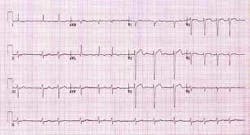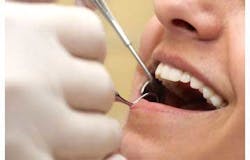Improvement of oral hygiene through dental scaling was associated with a decreased risk of cardiovascular events. The goal of one study was to investigate whether dental scaling can reduce the risk of atrial fibrillation (AF).(1) According to the study in the International Journal of Cardiology, there a relationship between periodontal health and cardiac dysrhythmia. The researches and authors of the study believe that one way to lower the risk of developing atrial fibrillation, the most common type of sustained cardiac dysrhythmia, is by receiving a dental scaling at least once a year to inflammatory burden.
Atrial fibrillation is the most common type of arrhythmia (abnormal heart rhythm).(2) When atrial fibrillation and other arrhythmias occur, the electrical activity of the heart is disorganized, causing an irregular heartbeat. The irregular heartbeat disrupts the flow of blood through the heart. Atrial fibrillation affected approximately 2.7 million Americans in 2010, according to the U.S. Centers for Disease Control and Prevention (CDC).(3) AF's disorganized cardiac electrical impulses and incomplete atrial emptying place patients at significantly increased risk for clots, strokes, and heart failure, the CDC noted. Symptoms of atrial fibrillation include: Irregular or rapid heartbeat; Palpitations; Lightheadedness, Extreme fatigue; and Shortness of breath chest pain. However, not all people with atrial fibrillation experience symptoms.(3)
In this study, the researchers used data from Taiwan's National Health Insurance Research Database (NHIRD) for the year 2000 to identify 28,909 subjects age 60 or older who had no history of cardiac dysrhythmias.(1) The NHIRD is a cohort database of medical claims data for 1 million Taiwanese citizens that is representative of the 26 million citizens enrolled in Taiwan's mandatory National Health Insurance (NHI) universal coverage program. Although each study participant's identity is encoded to protect confidentiality, the code remains consistent throughout the dataset, which allowed the study authors to follow insurance claims by the same subject. Subjects from the group who received dental scaling at least once per year from 1998 to 2000 were referred to as the "exposed" group. This group was then matched to a total of 13,564 individuals with similar age, sex, and significant underlying diseases using risk set sampling and International Classification of Diseases, Ninth Revision, Clinical Modification (ICD-9-CM) codes. The "nonexposed" group had not received scaling from 1998 to 2000. All subjects were followed until five years after enrollment or occurrence of new-onset atrial fibrillation, as defined by hospital discharge diagnosis or confirmed more than twice in an outpatient setting. The researchers found that the group that had regular dental scaling also had a lower occurrence rate of new-onset AF. After further adjustment for age, sex, and other comorbidities, dental scaling was associated with a reduced risk of AF. The researchers also discovered that more frequent dental scaling visits led to further reduced risk. The authors hypothesize that their study proposes that the risk of AF can be reduced through dental scaling.
Atrial fibrillation is the most common arrhythmia in clinical practice. Other studies have indicated that inflammation might play a significant role in the initiation, maintenance, and perpetuation of AF. Inflammatory markers such as interleukin-6 and C-reactive protein are elevated in AF and correlate to longer duration of AF, success of cardioversion, and thrombogenesis.(4) Furthermore, the inflammatory process might be modulated by the use of statins, angiotensin-converting enzyme inhibitors, or glucocorticoids. The purpose of this study is to analyze the current published reports on the relationship between inflammation and AF and the potential therapeutic options available to modulate the inflammatory milieu in AF. As many now consider inflammation to be an independent risk factor for the initiation and maintenance of AF, studies are ongoing in an attempt to reduce the inflammatory burden in patients with AF by novel therapeutic interventions. Statins and ACE-Is/ARBs have shown the most promise by modulating the inflammatory effects and inhibiting cardiac remodeling.(4) Studies in animals have found that atorvastatin (Pfizer brand name Lipitor) prevents AF by inhibiting inflammation in a canine sterile pericarditis model(5). The CRP levels were decreased, atrial effective refractory period (AERP) was increased, atrial conduction time decreased, and AF duration was diminished in the atorvastatin arm on post-operative day 2. In another similar study in a canine model of inducing AF by rapid atrial pacing, simvastatin-treated (Merck and Co brand name Zocor) dogs had longer AERP and consequently shorter duration of AF.(6) Tooth Loss and Cardiovascular Disease Mortality Risk – Results from the Scottish Health Survey showed that being edentulous was an independent predictor of total CVD mortality, although this was mainly driven by fatal stroke events.(7) Researchers continue to explore whether the data merely links these conditions or if a causal relationship exists. The American Heart Association issued a statement that periodontal disease has not been proved to cause atherosclerotic heart disease or stroke, and that treating periodontitis has not been proved to prevent heart disease or stroke.(8) However, many researchers contend that while no causal link has been quantitatively established, the role of inflammation in both periodontitis and heart disease suggests an association. Poor oral hygiene can be prevented, and can cause periodontal disease and dental decay.
In conclusion, the risk of AF was lower in subjects receiving dental scaling. Improvement of oral hygiene by dental scaling may be a simple and useful way to prevent AF.
References 1. Chen S.-J., Liu C.-J., Chao T.-F., Wang K.-L., Chen T.-J., Chou P., Wang F.-D., (...), Chiang C.-E. Dental scaling and atrial fibrillation: A nationwide cohort study. (2013) International Journal of Cardiology. 2. Fuster V, Ryden LE, Cannom DS, Crijns HJ, Curtis AB, Ellenbogen KA, et al. ACC/AHA/ESC 2006 Guidelines for the Management of Patients with Atrial Fibrillation: A Report of the American College of Cardiology/American Heart Association Task Force on Practice Guidelines and the European Society of Cardiology Committee for Practice Guidelines.* Circulation. 2006;114(7):e257–354. 3. http://www.cdc.gov/dhdsp/data_statistics/fact_sheets/fs_atrial_fibrillation.htm/. 4. Issac TT, Dokainish H, and Lakkis NM. Role of Inflammation in Initiation and Perpetuation of Atrial Fibrillation, A Systematic Review of the Published Data. J Am Coll Cardiol 2007;50:2021–8. 5. Kumagi K., Nakashima H., Saku K.; The HMG-CoA reductase inhibitor Atorvastatin prevents atrial fibrillation by inhibiting inflammation in a canine sterile pericarditis model, Cardiovasc Res 62 2004 105-111. 6. Shirosheta-Takeshita A., Schram G., Lavoie J., Nattel S.; Effect of simvastatin and antioxidant vitamins on atrial fibrillation promotion by atrial-tachycardia remodeling in dogs, Circulation 110 2004 2313-2319. 7. Watt RG, Tsakos G, de Oliveira C, Hamer M (2012) Tooth Loss and Cardiovascular Disease Mortality Risk – Results from the Scottish Health Survey. PLoS ONE 7(2): e30797. doi:10.1371/journal.pone.0030797. 8. Lockhart PB, Bolger AF, Papapanou PN, Osinbowale O, Trevisan M, Levison ME, Taubert KA, Newburger JW, Gornik HL, Gewitz MH, Wilson WR, Smith SC, and Baddour LM. Periodontal Disease and Atherosclerotic Vascular Disease: Does the Evidence Support an Independent Association?: A Scientific Statement From the American Heart Association. Circulation: April 18, 2012. http://circ.ahajournals.org/content/early/2012/04/18/CIR.0b013e31825719f3.










